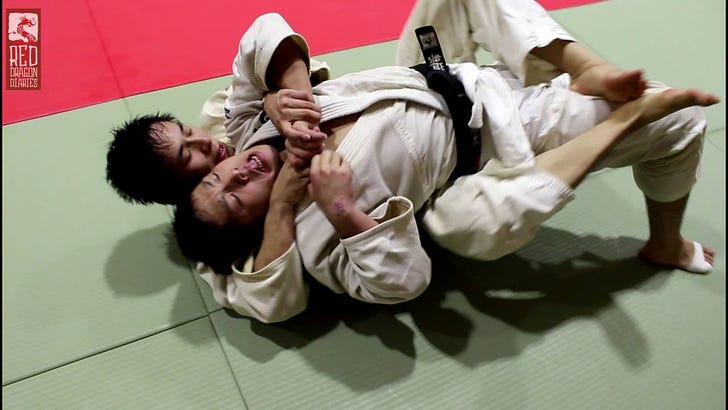Kosen Judo and the origins of MMA
When I was in Japan in the mid-1990s almost no one outside of a small group of MMA fans had ever heard of BJJ or Gracie Jiujitsu. Sometimes when I went to a judo club to practice I would just explain that I was a "newaza specialist" (ground technique specialist) or even that I wanted to do Kosen-style judo.
The Imperial Universities that specialized in Kosen judo did so partially because they were nerds! One could become adept at newaza with less natural athleticism and less practice than was required to become a true tachiwaza (standing technique = dynamic throws) specialist. A relatively small amount of training in ground technique allows a fighter to completely dominate an untrained opponent. The Kosen competitors would simply drag their opponent to the mat without using any flashy throws or takedowns, and then submit or pin them. More video.
I cannot really tell from the video whether these Kosen practitioners have also adopted techniques from modern BJJ. I see some spider guard, but apparently that is an old Kosen style! Don't let the black belts fool you. In Japan you go from white to black belt directly, and 1st dan black belt just means you know the basic moves and are still very much a student. These guys in the video don't look all that advanced to me for the most part. (It's not easy to be admitted to Kyoto University, by the way.)
Here's a top-level Kosen guy. He's destroying those scrubs in Canada ;-)
Wikipedia: Kosen judo (高專柔道 Kōsen jūdō) is a variation of the Kodokan judo competitive ruleset that was developed and flourished at the kōtō senmon gakkō (高等専門学校)(kōsen (高專)) technical colleges in Japan in the first half of the twentieth century. Kosen judo's rules allow for greater emphasis of ne-waza (寝技, ground techniques) than typically takes place in competitive judo and it is sometimes regarded as a distinct style of judo.
Today, the term "kosen judo" is frequently used to refer to the competition ruleset associated with it that allows for extended ne-waza. Such competition rules are still used in the Nanatei Jūdō / Shichitei Jūdō (七帝柔道 Seven Imperials Judo) competitions held annually between the seven former Imperial universities. Similarly, there has been a resurgence in interest in Kosen judo in recent years due to its similarities with Brazilian jiu jitsu.
Brazilian Jiujitsu (BJJ) was introduced to Brazil through the Gracie family by judoka Mitsuyo Maeda. Maeda had significant experience fighting wrestlers and boxers; from this experience he developed a theory of combat that has evolved into modern MMA.
According to Renzo Gracie's book Mastering Jujitsu, Maeda not only taught the art of judo to Carlos Gracie, but also taught a particular philosophy about the nature of combat based on his travels competing and training alongside catch-wrestlers, boxers, savate fighters, and various other martial artists. The book details Maeda's theory that physical combat could be broken down into distinct phases, such as the striking phase, the grappling phase, the ground phase, and so on. Thus, it was a smart fighter's task to keep the fight located in the phase of combat that best suited his own strengths. The book further states that this theory was a fundamental influence on the Gracie approach to combat.



